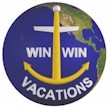Alaska Cruise from
Seattle to Juneau
Aug 20-27, 2001
On the Spirit of Oceanus, Cruise West
20
AUG 01 - Monday
Cruise West picked up the passengers from out of town at the airport and took
them to pier 69 on the Seattle waterfront for the early morning departure to
Victoria, BC on Vancouver Island, Canada. We simply appeared there on our own
as we live in Seattle. We were easily recognized as we were wearing the bear
pins sent to us with the cruise documents. A nice touch. This was the fast
ferry, the new Victoria Clipper IV, making it up there in just 2 hours. 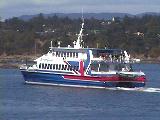
We
arrived in Victoria at 10:30 am. The friendly Cruise West staff, that checked
us in in Seattle also greeted us here. Cruise West has booked a hospitality
suite at Laurel Point Inn,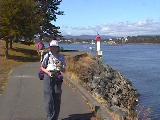
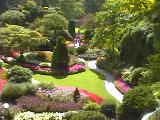
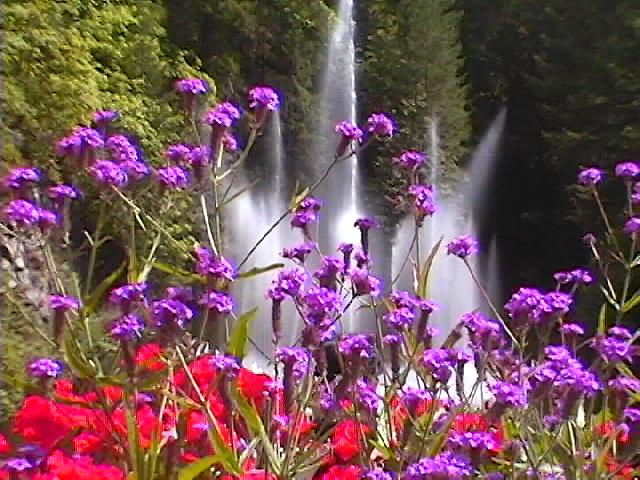 I especially enjoyed the Japanese Gardens.
I especially enjoyed the Japanese Gardens.
The
bus takes us back to the harbor for the 4:00pm boarding of the Spirit of
Oceanus. We sail at 5:30pm.
We're greeted with a glass of champagne and issued nametags with our first
names only to wear. It's another nice touch and people were wearing these all
week and calling each other by our first name. Thr feeling of family takes
roots very quickly. The boarding is smooth and quick. Our luggage is already
in our suite. It’s the largest cabin I’ve ever had on any ship so far.
We’re in a classic suite # 338. This stabilizer-equipped vessel is Cruise
West's first ocean-going ship. There are 57 large suites that vary in size,
but all have ocean views from very large portholes on the lowest deck or
picture windows. Twelve suites feature private teak balconies.
Choose from six categories of outside suites, increasing in price:
Superior suites (Cabins 250, 331, 329)
• Located on the Oceanus and Main Decks, Superior Suites average 215 square
feet in size and have three portholes (Oceanus Deck) or picture windows (Main
Deck)
Magestic suites (Cabins 252-262)
• These 240 square foot suites are located on the Main Deck. They feature a
minimum of 2 portholes and full-length wardrobes
Premium suites (Cabins 414-428)
• These suites are located on the Club Deck and feature a large picture
window opening onto an outside walkway and a walk-in closet. They average 235
square feet
Classic suites (Cabins 330, 332-348)
• Classic Suites located on the Oceanus Deck feature a picture window right
in the hull and have two wardrobes. Classic Suites average 250 square feet
Explorer suites (Cabins 505-512)
• Explorer Suites on the Sports Deck feature a sliding glass door leading to
a private balcony and a walk-in closet. Explorer Suites are 277 square feet in
size
Grand Titan suites (Cabins 601-604)
• These magnificent suites are atop the ship on the Sun Deck. They feature a
sliding glass door leading to a private balcony, a spacious wardrobe, and a
large picture window. They are 353 square feet in size
Passengers
are welcomed to their suite with a glass of champagne and a bowl of fresh
fruit. Every suite is well appointed with polished wood paneling, a book
case with TV and VCR, 2 binoculars, safe, large wardrobe or walk in
closet with 2 bathrobes, a mini-fridge stocked with complimentary beverages,
twin beds convertible to king-size, separate sitting area with a velvet couch,
chair and glass table, ample reading lights and several lamps, a
vanity with lot's of mirrors and side mirrors that turn so you can see your
sides and back. There's plenty of storage space. The bathroom has marble
counters, a hair dryer, thick cotton towels, complimentary Bronnley Fine
English toiletteries and bath products, and a shower. A pool and hot tub are
located on the Sports Deck, and one deck below is the Club Lounge complete
with the Bar, where Claudio is the world's friendliest bartender.  The piano, the stereo sound system, a stocked video and book library, computer
for sending e-mails, a card room with board games, and an exercise room
are also located here. The Oceanus Lounge below is connected via a spiral
stair case. This is where onboard briefings and lectures are held. An elevator
provides access to all five passenger levels. The Spirit of Oceanus features 2
venues for meals, the Bistro on the Sports Deck for buffet breakfast and
lunches (weather permitting). It's heated inside the covered area.
The piano, the stereo sound system, a stocked video and book library, computer
for sending e-mails, a card room with board games, and an exercise room
are also located here. The Oceanus Lounge below is connected via a spiral
stair case. This is where onboard briefings and lectures are held. An elevator
provides access to all five passenger levels. The Spirit of Oceanus features 2
venues for meals, the Bistro on the Sports Deck for buffet breakfast and
lunches (weather permitting). It's heated inside the covered area. 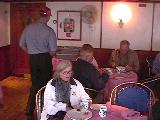 All
meals are also served in the open-seating Pacifica Restaurant.
All
meals are also served in the open-seating Pacifica Restaurant.  Every meal here is casual and offer Continental cuisine and specialties
from the region the ship is cruising. The chef picks up fresh food along
the way. I saw them load the crabs at one port. Fresh bread is baked onboard
daily. Complimentary snacks are always set out in the Club Lounge. Soft drinks
are complimentary.
Every meal here is casual and offer Continental cuisine and specialties
from the region the ship is cruising. The chef picks up fresh food along
the way. I saw them load the crabs at one port. Fresh bread is baked onboard
daily. Complimentary snacks are always set out in the Club Lounge. Soft drinks
are complimentary.
Cruise West is not an American built ship like all other Cruise West ships
are. Therefore, she is registered in the Bahamas and carry an international
crew. She cannot cruise between 2 U.S ports. We boarded in Victoria for this
reason.
After
the mandatory safety meeting and donning of life jackets to prepare for an
emergency, we’re off. We sail out of Victoria, turn east at first into
the Juan de Fuca Straight, then north up the west side of San Juan Island and
Stuart Island. It’s warm and sunny.
We sail east of Sidney and Swartz Bay, west of James Island and Pender Island,
through the narrow passage at Galiano Island, north up the straight of Georgia
between Nanaimo and Vancouver. We see the lights from both cities on both
sides of the ship. It's absolutely wonderful, but it's also the last of the
nice warm weather we will see all week.
21
AUG 01 - Tuesday
Today we cruise British Columbia's Inside Passage all day. The weather is
cloudy and cool in the morning and it’s raining on and off. The seas are
choppy as we enter the Discovery Passage at 6:00am into Campbell River. At
7:15am we pass Ripple Rock at Seymour Narrows on Quadra Island. It was
dynamited to make the passage safer. We enter the Johnston Straight at Chatham
Point. We’re having breakfast outside on the top deck at the Bistro in the
rain, wind and rainbow. 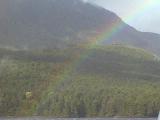 The terrain gets steeper and wilder as we cruise north. Bald Eagles soar
overhead. At Robson Bight, Orca whales rub their bellies on the rocks. We pass
Telegraph Cove on Cormorant Island around noon.
The terrain gets steeper and wilder as we cruise north. Bald Eagles soar
overhead. At Robson Bight, Orca whales rub their bellies on the rocks. We pass
Telegraph Cove on Cormorant Island around noon.
At Alert Bay we see the worlds tallest totem poles at 170 feet. 
Captain
Malcolm Scanlan stops for wildlife viewing. At 1:15pm we spot the Orcas in
Queen Charlotte Straight. Everyone abandons lunch and run up on the deck in
pouring down rain, to watch them. Captain Malcolm stops the ship and we just
sit there for 30 minutes watching the Orcas feed on salmon at the surface.
They are traveling southeast, we continue north.
At 3:00 pm we pass Port Hardy and leave the sheltered and protected waters of
Vancouver Island behind. Heading out into open water of Queen Charlotte Sound
between Cape Scott and Cape Calvert Island, we feel the waves from a gusty day
outside Tokyo. Here at 3:30pm we are followed by 100’s of Pacific Whitesided
Dolphins, what a sight! 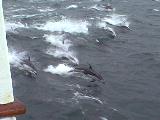 They
seem to enjoy themselves and ride our waves for half an hour. It’s still
pouring down rain, but we all stay on deck enjoying this show.
They
seem to enjoy themselves and ride our waves for half an hour. It’s still
pouring down rain, but we all stay on deck enjoying this show.
click_here_to_view_dolphin_video_clip
At
6:00 pm is the Captain’s cocktail party. No need to dress up, though. This
is a very casual ship. At 7:00 pm we see Humpback Whales breeching off Namu
and Burke Channel. What a day!
This is a great start.
22
AUG 01 - Wednesday
Today, we cruise the wilderness of Northern British Columbia, approaching the
Skeena River on the way to visit Prince Rupert.
We’re cruising through the Grenville Channel with Pitt Island on the west
side and it’s still raining and foggy, only 55 degrees today. At 10:00 am we
pass Ogden Channel and turn towards Kennedy Island and up the Malacca Passage.
At 11:00 am, our cute little naturalist Margie has a talk about the native
peoples of Alaska, which is very interesting. Immediately after that is the
zodiac safety briefing, which is mandatory for everyone who wants to
participate in the zodiac trips. Around noon we pass the mouth of the Skeena
River. At 1:00 pm we arrive at Prince Rupert. Our optional shore excursion to
old Metlakatla was cancelled due to lack of participation. This was a
dissappointment at first. Sign-up closed early on the day we boarded.
Not to worry, we find the hike down Butze Rapids Trail with 2 other guests.
The 4 of us set off together. 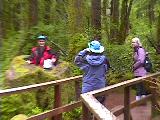 The rapids are located on the Fern Passage and offer a spectacular display of
reversing tides. It’s connected to the Grassy Bay Trails in the Morse Basin
on Kaien Island, very interesting walking through the rain forest in the rain!
We get dropped off there and later walk back into town.
The rapids are located on the Fern Passage and offer a spectacular display of
reversing tides. It’s connected to the Grassy Bay Trails in the Morse Basin
on Kaien Island, very interesting walking through the rain forest in the rain!
We get dropped off there and later walk back into town.
The ship is tied up in Cow Bay, not a
very interesting area. Cruise West is running a complimentary shuttle up the
hill to the Prince Rupert’s Museum of Northern British Columbia. Cruise West
included the entry tickets to this museum, which has many Tsimshian
relics and artifacts on display. Hundreds of ancient village sites,
petroglyphs, and a rich oral tradition give evidence of thousands of years of
culture among the local Tsimshian people. Their artifacts, created from the
riches of the sea and forest, stock museums around the world. Ancient village
sites are so numerous that archeologists have barely touched many of them.
The Museum is located in the award-winning Chatham Village longhouse. The
building itself is constructed from massive cedar logs and beams, and the
smell of cedar surrounds you when you enter. The collections span 10,000 years
of human history on the north coast, an eye-opening collection of artifacts
from pre-history to pioneer times. If you visit, ask about carvers at work in
local carving sheds. Also ask about public programs, and watch for activities
and shows in the galleries. There's a superb selection of art and books in the
gift shop. Some special archeological and historical programs are arranged
through the Museum. The museum gift shop is actually an impressive art
gallery, offering original works of art by modern Northwest Coast artists in
wood, argillite, an unusually pure slate-like stone found only in the Queen
Charlotte Islands, silver and other media. Protected by law, it can only be
carved and sculpted by the Haida Indians. This boathouse has a fancy roof.
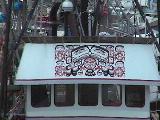
It rains all day.
Surrounded
by forested peaks, mist-bordered islands and rich waters, Prince Rupert is the
City of Rainbows. By virtue of its location and its transportation network
Prince Rupert is a gateway
to lands and waters in all directions. Fishing, forestry, transportation and
tourism form the basis of its economy and its rich history.
The Spirit of Oceanus departs Prince Rupert at 7:00 pm and after another
delicious dinner, we are entertained in the bar by Brett, who is always very
animated. 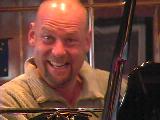 Around midnight we all know that we are passing through the Dixon Passage by
the swaying and rolling of the ship. I'm wearing my seabands. Stuff is falling
off tables and shelves. This is the boundary between Alaska and Canada. It’s
time to set the clocks back one hour.
Around midnight we all know that we are passing through the Dixon Passage by
the swaying and rolling of the ship. I'm wearing my seabands. Stuff is falling
off tables and shelves. This is the boundary between Alaska and Canada. It’s
time to set the clocks back one hour.
23
AUG 01 - Thursday
Morning cruise of Misty Fjord's National Park. At 5:30 am we pick up 2
naturalists and their kayaks at the T- junction of Behm Canal and Rudyerd Bay
in the Misty Fjord’s National Monument. Misty
Fiords National Monument may be reached by floatplane or boat. No permanent
roads exist.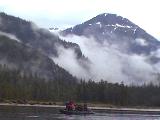 Remote
and wild, Misty Fiords National Monument supports many nearly untouched
coastal ecosystems and covers about 3,570 square miles (9,246 square
kilometers). Several major rivers and hundreds of streams are fed by misty
rain and snow each year, as well as by melt water from glaciers that begin
near the Canadian border.
Remote
and wild, Misty Fiords National Monument supports many nearly untouched
coastal ecosystems and covers about 3,570 square miles (9,246 square
kilometers). Several major rivers and hundreds of streams are fed by misty
rain and snow each year, as well as by melt water from glaciers that begin
near the Canadian border. 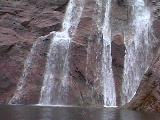 Mineral
springs and volcanic lava flows add to the unique geological features. Located
in the southernmost part of southeast Alaska, Misty Fiords National Monument
extends from Dixon Entrance to beyond the Unuk River. The western boundary is
22 miles east of Ketchikan. It is about 680 air miles from Seattle. The Forest
Service manages the area for public use. Behm Canal, a deep, long waterway of
the northeastern Pacific Ocean, leads to the heart of the Monument. Rock walls
jutting 3,000 feet (900 meters) above the ocean surround picturesque areas
such as Walker Cove and Rudyerd Bay. Flight seers, boaters, and hikers may
photograph, fish, hunt, or view the long, deep, narrow fjords and steep-walled
canyons- enjoying the outstanding scenic beauty and rugged terrain of Misty
Fiords. Most wildlife common to southeast Alaska may be found in Misty Fiords.
Bald eagles nest in large trees near rivers and shorelines, where pairs share
the raising of young during summer. Alaska's famous brown bears, black bears,
Sitka black-tailed deer, wolves, and mountain goats are the most common large
mammals in Misty Fiords. Beaver, mink, marten, wolverine, and river otter are
common small animals. In Behm Canal and nearby ocean waters, porpoises,
whales, sea lions, and seals are often sighted. The majestic landscape at
Misty Fiords National Monument was created by thousands of years of
glaciations and other earth processes. Volcanoes, moving snow and ice, and
wave action, created the unique features of Misty Fiords. The island called
"New Eddystone Rock" is a pillar of basalt.
Mineral
springs and volcanic lava flows add to the unique geological features. Located
in the southernmost part of southeast Alaska, Misty Fiords National Monument
extends from Dixon Entrance to beyond the Unuk River. The western boundary is
22 miles east of Ketchikan. It is about 680 air miles from Seattle. The Forest
Service manages the area for public use. Behm Canal, a deep, long waterway of
the northeastern Pacific Ocean, leads to the heart of the Monument. Rock walls
jutting 3,000 feet (900 meters) above the ocean surround picturesque areas
such as Walker Cove and Rudyerd Bay. Flight seers, boaters, and hikers may
photograph, fish, hunt, or view the long, deep, narrow fjords and steep-walled
canyons- enjoying the outstanding scenic beauty and rugged terrain of Misty
Fiords. Most wildlife common to southeast Alaska may be found in Misty Fiords.
Bald eagles nest in large trees near rivers and shorelines, where pairs share
the raising of young during summer. Alaska's famous brown bears, black bears,
Sitka black-tailed deer, wolves, and mountain goats are the most common large
mammals in Misty Fiords. Beaver, mink, marten, wolverine, and river otter are
common small animals. In Behm Canal and nearby ocean waters, porpoises,
whales, sea lions, and seals are often sighted. The majestic landscape at
Misty Fiords National Monument was created by thousands of years of
glaciations and other earth processes. Volcanoes, moving snow and ice, and
wave action, created the unique features of Misty Fiords. The island called
"New Eddystone Rock" is a pillar of basalt. 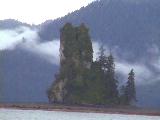 Sometime during the last 5 million years, the basalt came from fractures in
the floor of Behm Canal. The broken, haphazard texture of these basalts
indicates that New Eddystone Rock was part of a volcanic vent where magma rose
repeatedly to the surface of the earth.
Sometime during the last 5 million years, the basalt came from fractures in
the floor of Behm Canal. The broken, haphazard texture of these basalts
indicates that New Eddystone Rock was part of a volcanic vent where magma rose
repeatedly to the surface of the earth.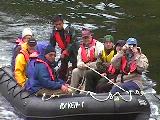
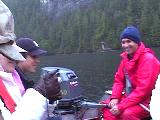
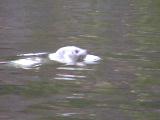
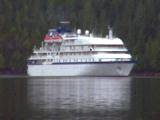
We cruise on up to the mouth of the river, but see no bears
this morning. We do see many harbor seals, feeding on chum and pink salmon.
There
are hundreds of Bald Eagles here too. We also see the rare little Marbled
Murrelets bird, which lives only on the old growth forest, and we also see
Kingfishers.
The Punchbowl Cove area described above sure is impressive, rising straight up
3,500 feet to the sky. New Eddystone Rock reminds me of Phantom Island in
Crater Lake.
This afternoon we will pay a visit to
Metlakatla on Annette Island near Ketchikan. We’re cruising out the Behm
Canal, up the Revillagiedo Channel north into Nichols Passage to Metlakatla, a
Tsimshian native village and the cultural highlight of the entire trip. We
arrive at 3:00 pm and it’s raining. Metlakatla,
Alaska is located on the west side of the Annette Islands in Southeast
Alaska. The first island to begin what Alaskan’s call the Panhandle. Here
we visit the Father Duncan Cottage Museum. 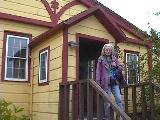 This home was built in 1891 for Anglican missionary William Duncan. The museum
contains personal items of Mr. Duncan. Original furnishings, turn of the
century collections of music boxes such as Thomas A. Edison's second invented
phonograph made from a treadle sewing machine. Telephones brought from Canada.
Medical supplies, educational material, and musical Instruments.
This home was built in 1891 for Anglican missionary William Duncan. The museum
contains personal items of Mr. Duncan. Original furnishings, turn of the
century collections of music boxes such as Thomas A. Edison's second invented
phonograph made from a treadle sewing machine. Telephones brought from Canada.
Medical supplies, educational material, and musical Instruments.
We toured the Annette Island Packing Company for up close observations of
seafood processing. Here they process abalone, sea cucumber, sea urchin black
cod, halibut and four species of salmon. There is a company gift shop to send
home a sample of the finest salmon, packaged in keepsake wooden boxes
decorated with Northwest Coast Tsimshian Art. Then we attended the Tribal
Longhouse Dance Performance 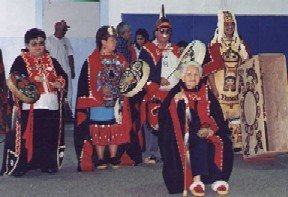 and
presentation about the local artwork.
and
presentation about the local artwork.
The Le Sha'as as it's called by the Tsimshian is a clan house, shared by The
RAVEN, The EAGLE, The WOLF and The KILLERWHALE clans. 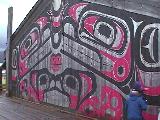
The rhythm of the drums call the four major clans of the Tsimshian Nation and
their neighbors to come, to dance and share a happy moment.
Share your stories to teach and learn to preserve a way of life. 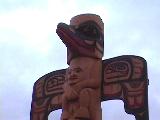 Everyone
really enjoyed this experience to visit the native peoples and participate in
their traditional ways for a day. I purchased some beautiful handmade earrings
from one of the artist. Back on the ship for dinner, there is no need to dress
up, just putting something dry on after a hot shower feels so good.
Everyone
really enjoyed this experience to visit the native peoples and participate in
their traditional ways for a day. I purchased some beautiful handmade earrings
from one of the artist. Back on the ship for dinner, there is no need to dress
up, just putting something dry on after a hot shower feels so good.
24 AUG 01 - Friday
We
cruised up Clarence Straight from Metlakatla during the night and found
ourselves on the west side of Onslow Island, Etolin Island and Zarembo Island
in the early morning. We took the narrow Snow Passage into Sumner Straight,
something no ship bigger than us can do. It's so nice to see Alaska, really
see Alaska, and the only way is on a small ship. Snow Passage is a very narrow
passage between the islands. We looked for dolphins or humpback whales 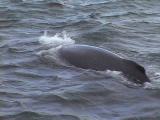 and we also spotted the Common Murres birds, but I couldn't get a photo.
and we also spotted the Common Murres birds, but I couldn't get a photo.
Around 10am we entered the Wrangell Narrows, a winding channel between Mitkof
and Kupreanof Islands, widely used by fishing boats and Alaska ferries, also
too narrow for large cruise ships. 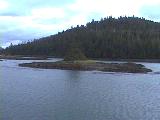
This is another "don't miss" spot - but only the
smaller cruise ships and the Alaska ferries can squeeze through! About 22
miles long, there are some 60 plus lights and buoys to mark it - it's one of
those "keep your finger on the chart" places for navigators.
This passage averages half a mile wide at high tide. We cruised at low tide.
Amazing! A Bald Eagle sits on top of a marker only 3 feet away as we pass by.
We also see Sitka Black-tailed deer along the shore. Wrangell
Narrows, a placid channel along which only small ships can cruise, is a
highlight of this voyage and a perfect example of why small ship cruising is
so delightful.
At 2:00 pm we arrived in Petersburg
located on the tip of Mitkof Island. Also known as Little Norway, this is
a town that commercial fishing built. 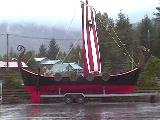 Settled by Norwegian immigrants Peter Bushman and his son August, they shipped
their first fish to Seattle packed in the ice from nearby LeConte Glacier.
After establishing their niche in the competitive salmon fisheries of
Southeast Alaska, many Petersburg fishermen went "to west'ard" - to
the lucrative King Crab and herring fisheries of the Bering Sea and other
places in western Alaska. Take a walk north of town to where you can get a
good look at Wrangell Narrows and the rapid tides that pour through it. At
times the tidal current swirls past the faces of the cannery docks at some 5
knots or better - making for very challenging 'landings' for the heavily laden
fishing vessels that dock here.
Settled by Norwegian immigrants Peter Bushman and his son August, they shipped
their first fish to Seattle packed in the ice from nearby LeConte Glacier.
After establishing their niche in the competitive salmon fisheries of
Southeast Alaska, many Petersburg fishermen went "to west'ard" - to
the lucrative King Crab and herring fisheries of the Bering Sea and other
places in western Alaska. Take a walk north of town to where you can get a
good look at Wrangell Narrows and the rapid tides that pour through it. At
times the tidal current swirls past the faces of the cannery docks at some 5
knots or better - making for very challenging 'landings' for the heavily laden
fishing vessels that dock here. 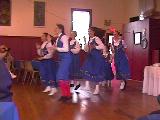 This includes traditional Norwegian pastries and coffee accompanied by a dance
performance by the children of the Leikaringen Dancers. The
Hall is the center of most of the town's social life (outside the bars); when
the fishermen wanted to attract women to marry, they knew they had to have a
place that their wives & children could frequent, so they built the hall.
The show was a group of children, dressed in handmade blue costumes
embroidered with Alaska flowers, who performed several Norwegian dances for
us, and did very well.
This includes traditional Norwegian pastries and coffee accompanied by a dance
performance by the children of the Leikaringen Dancers. The
Hall is the center of most of the town's social life (outside the bars); when
the fishermen wanted to attract women to marry, they knew they had to have a
place that their wives & children could frequent, so they built the hall.
The show was a group of children, dressed in handmade blue costumes
embroidered with Alaska flowers, who performed several Norwegian dances for
us, and did very well. 
Of course, it’s raining and cool. I
feel right at home in more ways than one, being of Swedish decent and living
in rainy Seattle.
Recommended for visitors: Take a flight to Le Conte Glacier. 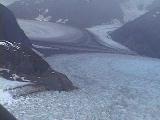 Just 18 miles east from town is LeConte Bay, the most southerly glacier that
reaches the saltwater in Alaska. Sometimes substantial bits of ice are carried
by the tide into Wrangell Narrows, the channel in front of town. Both air
tours and boat tours are available in Petersburg. There's also an Information
Center, located at the harbormasters office at the town dock. Sons of Norway
Hall has a good crafts store, and historic Sing Yee Alley is nearby. We visit
the museum in town to escape the rain a bit.
Just 18 miles east from town is LeConte Bay, the most southerly glacier that
reaches the saltwater in Alaska. Sometimes substantial bits of ice are carried
by the tide into Wrangell Narrows, the channel in front of town. Both air
tours and boat tours are available in Petersburg. There's also an Information
Center, located at the harbormasters office at the town dock. Sons of Norway
Hall has a good crafts store, and historic Sing Yee Alley is nearby. We visit
the museum in town to escape the rain a bit.
LeConte Glacier Bay is a 12 mile-long
fjord carved out of the coastal mountain range by glaciers over the course of
thousands of years. LeConte Glacier is North America's southern most tidewater
glacier. 
We have chosen the floatplane excursion over LeConte
Glacier this afternoon and keep our fingers crossed for better weather. All
helicopter tours are cancelled. As luck would have, we’re off on the most
exotic excursion in my life. First off, we see White Mountain goats literally
hanging off the steep cliffs. How do they stay up there? Then the glacier
itself: ….. so baby blue, I had
no idea! What a sight! Incredible experience.  The
pilot is so good; he flies this way and that way and back, gives all of us in
the 4 seater Cessna 180 a chance to see. The clouds allow us to fly below
them, adding a mystique to the experience.
The
pilot is so good; he flies this way and that way and back, gives all of us in
the 4 seater Cessna 180 a chance to see. The clouds allow us to fly below
them, adding a mystique to the experience.
Flying out over the LeConte Bay, we see hundreds of blue icebergs filled with
seals. 
This
was worth every penny to see. It was difficult to "come down" to
earth again, after such an enriching and exciting experience. But another
delicious dinner was calling and a chance to share our experiences of the day
with our fellow travelers, who by now have become very close friends.
25 AUG 01
- Saturday
Today we cruise the pristine waters of Tracy Arm with its twin Sawyer
Glaciers. In the afternoon, we will lock for Humpback whales in Frederick
Sound, a favorite hangout for them and other whales.
At 6:00 am this morning we enter into the pristine waters of Tracy Arm and
find it almost filled with icebergs and "bergie bits" that have
calved just this past week according to the Captain. This makes for very slow
going.
The Radisson Seven Seas Mariner runs out of time before getting to the
“viewing” spot and decides to turn around and head for Juneau.  We
have time. However, it is not safe to launch the zodiacs here as planned and
we do so later on our way out and cruise up close to a couple of waterfalls.
We spot Marguerite Island named after Chuck West’s wife Marguerite, which I
find touching.
We
have time. However, it is not safe to launch the zodiacs here as planned and
we do so later on our way out and cruise up close to a couple of waterfalls.
We spot Marguerite Island named after Chuck West’s wife Marguerite, which I
find touching. 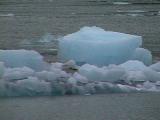 Harbor
seals live on the icebergs here close to the South Sawyer Glacier. They give
birth here in the summer and they know that the Orcas don’t come up this far
in Tracy Arm. The newborns are safe from its number one predator. When they
are 6 weeks old, they are ready to leave and be on their own. Many
experienced travelers regard Tracy Arm as the most beautiful place in all of
Alaska. Fronted by icebergs and icepacks, growlers and bergy bits, the Twin
Sawyer Glaciers guard this primeval wonderland.
Harbor
seals live on the icebergs here close to the South Sawyer Glacier. They give
birth here in the summer and they know that the Orcas don’t come up this far
in Tracy Arm. The newborns are safe from its number one predator. When they
are 6 weeks old, they are ready to leave and be on their own. Many
experienced travelers regard Tracy Arm as the most beautiful place in all of
Alaska. Fronted by icebergs and icepacks, growlers and bergy bits, the Twin
Sawyer Glaciers guard this primeval wonderland. 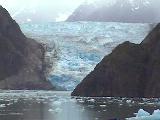
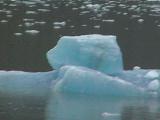
Going up Tracy Arm is going back into geologic history. The trees and
vegetation recede until it is only a canyon of bare rock. Hidden at the very
end are the two active glaciers, the North and the South Sawyer Glaciers.
Caution: small craft should approach these and other active glaciers with
care. "At times South Sawyer Glacier is very active, huge blocks of ice
falling off its face into very deep water. These set up waves which have been
observed as high as 25 feet; however a small boat can ride the waves safely if
it keeps a few miles distant from the glacier face and avoids getting packed
in the ice flow. " - United States Coast Pilot, Vol 8, 1969.
These walls are steep - when John Muir explored here in 1880, he and his
native paddlers had to tie their canoe to a rock, and climb up a hundred feet
up to a wide ledge to camp. They found plenty of berries and firewood and as
they sat around the fire, Muir looked across and counted 16 waterfalls.
Tracy and Endicott Arms are the major features of this
area. Both are long, deep and narrow fjords that penetrate more than 30 miles
into the heavily glaciated Coast Mountain Range. At the head of each of these
fjords are active tidewater glaciers, which continually calve icebergs into
the fjords. 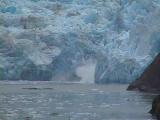 During the summer, both fjords have considerable floating ice ranging in size
from a three story building to hand size pieces. The ice often forms a barrier
to small boat traffic.
During the summer, both fjords have considerable floating ice ranging in size
from a three story building to hand size pieces. The ice often forms a barrier
to small boat traffic.
At 2:00 pm, we launched the zodiacs among the thinning of the icepack and
surrounded by Pigeon Guillemot birds and many waterfalls on all sides, it was
a great experience. 

At 5:00 pm we’re cruising very
slowly and reach Midway Point in Stephens Passage, heading south into
Frederick Sound. Here we spot the Humpback Whales. Of course, it’s raining,
but who cares? We brave the wind outside on the deck; this experience is not
to be missed. One surfaces 5 feet from the ship. WOW! 

Humpbacks are present in the Southeast Alaska waters
throughout the year, but the peak viewing period is from mid-June through
August. Scan waters along shorelines for the vapor forced out of their
blowholes when they exhale. Humpbacks make a variety of underwater sounds;
listen with a hydrophone to add a new dimension to the viewing experience.
Feeding humpbacks usually dive for 5 to 10 minutes, but they can remain
underwater for up to 30 minutes. Humpback whale watching sites in Southeast
include Chatham Strait, Frederick Sound, Stephens Passage, and Glacier Bay.
It's been another fantastic day in Alaska.
26 AUG 01
- Sunday
Early this morning we cruised into Sitka via Peril Straight and arrived at
8:00 am. Sitka is a historic former Russian American capital city. Like most
Southeast Alaska communities, Sitka is accessible only by air and sea. Sitka
is located on Baranof Island. At one time, when Sitka was the capital of
Russian America, Alexander Baranof–the "Lord of Alaska" ruled
here, where Tinglit warriors fought, and where Russian cannons are still on
guard. Sitka is the ancestral home of the Kiksadi Clan of the Tlingits.


 Since
this is Sunday, we want to visit St. Michael’s before the 3-hour standing
religious service begins. This tour is included with the Cruise West sailing.
Saint Michael's Cathedral contains an important collection of Russian
Orthodox art & church treasures. Built in 1844-48, it was totally
destroyed by fire in January 1966. Many of the icons and religious objects
were salvaged and are in the rebuilt structure.
Since
this is Sunday, we want to visit St. Michael’s before the 3-hour standing
religious service begins. This tour is included with the Cruise West sailing.
Saint Michael's Cathedral contains an important collection of Russian
Orthodox art & church treasures. Built in 1844-48, it was totally
destroyed by fire in January 1966. Many of the icons and religious objects
were salvaged and are in the rebuilt structure.
Located in a sheltered bay on the outside coast of Baranof Island, with a
dramatic view of dormant Mt. Edgecumbe volcano, Sitka is perhaps the most
scenic town in Southeast Alaska. When Juneau was woods and snow, and Ketchikan
was a native village, Sitka residents enjoyed theatre, fine wines and all the
riches that the sea otter trade provided her Russian residents. The cultural
influence of the Russian colonial period remains strong. Sitka is thought to
be the most beautiful of southeast Alaska cities. Nestled on the west side of
Baranof Island, it is flanked on the east by majestic snow-capped mountains,
and on the west by the Pacific Ocean. The climate is mild, but "liquid
sunshine" is a common occurrence! The most valuable natural resource is,
without a doubt, the people of Sitka, who share a pride in their home and a
love of life in its small-town splendor!
 The Center is a pioneering project that combines veterinary expertise and
volunteer efforts to nurse back to health hundreds of injured or sick birds of
prey, including bald eagles. Patients and residents of the Alaska Raptor
Center include bald eagles, golden eagles, hawks, ravens, falcons, owls and
other wild birds. The Alaska Raptor Center provides medical treatment to about
200 birds each year. In addition, they help educate more than 40,000 visitors
and 6,000 schoolchildren around the nation about raptors and habitat
preservation. While the center makes every effort to return eagles, hawks,
owls, and other raptors back to the wild, a few never recover flight and
remain housed at the Center as part of its education program. Our guide was
Voltar, a Bald Eagle injured in a collision with a high voltage power line.
The Center is a pioneering project that combines veterinary expertise and
volunteer efforts to nurse back to health hundreds of injured or sick birds of
prey, including bald eagles. Patients and residents of the Alaska Raptor
Center include bald eagles, golden eagles, hawks, ravens, falcons, owls and
other wild birds. The Alaska Raptor Center provides medical treatment to about
200 birds each year. In addition, they help educate more than 40,000 visitors
and 6,000 schoolchildren around the nation about raptors and habitat
preservation. While the center makes every effort to return eagles, hawks,
owls, and other raptors back to the wild, a few never recover flight and
remain housed at the Center as part of its education program. Our guide was
Voltar, a Bald Eagle injured in a collision with a high voltage power line.
This excursion includes a visit to Sitka National Historic Park - this is a
close to downtown opportunity to view a good collection of totem 'recarves'. 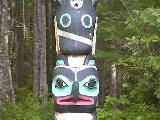 These poles are reproductions of poles collected from Prince of Wales Island
at the turn of the century. The park is located along the shore of Sitka
Sound, a pleasant half an hour walk from the dock where most cruise ship
passengers land.
These poles are reproductions of poles collected from Prince of Wales Island
at the turn of the century. The park is located along the shore of Sitka
Sound, a pleasant half an hour walk from the dock where most cruise ship
passengers land. 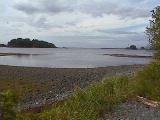 Totems celebrated legends, events, or simply the wealth and crest of the
family for whom it was created. The poles were neither worshipped nor had any
religious significance. They were records of the past in a culture that had no
written language. The 107 acres park preserves and interprets the site of a
Tlingit Indian Fort and the battle fought between the Russians and the
Tlingits in 1804. A fine collection of Haida & Tlingit totem poles were
moved there from the Louisiana Exposition in St. Louis in 1904, and in April
1996, a totem carved by a local carver was raised.
Totems celebrated legends, events, or simply the wealth and crest of the
family for whom it was created. The poles were neither worshipped nor had any
religious significance. They were records of the past in a culture that had no
written language. The 107 acres park preserves and interprets the site of a
Tlingit Indian Fort and the battle fought between the Russians and the
Tlingits in 1804. A fine collection of Haida & Tlingit totem poles were
moved there from the Louisiana Exposition in St. Louis in 1904, and in April
1996, a totem carved by a local carver was raised. 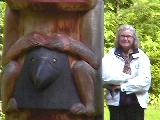 The museum contains an exhibit of Tlingit and Russian artifacts. There is an
active Tlingit arts program where the public can watch and talk to Native
Indian carvers. A self-guided oceanside trail leads past several totems to the
site of the Tlingit fort. The Main Building was closed for construction in
summer 2001. The totem studded trails remained open.
The museum contains an exhibit of Tlingit and Russian artifacts. There is an
active Tlingit arts program where the public can watch and talk to Native
Indian carvers. A self-guided oceanside trail leads past several totems to the
site of the Tlingit fort. The Main Building was closed for construction in
summer 2001. The totem studded trails remained open.
 At
3:00 pm we depart Sitka for an afternoon cruise of the Peril Straight between
Baranof and Chichagof islands looking for wildlife, such as Bald Eagles in the
Olga and Neva Straights. As before, we see many Bald Eagles.
At
3:00 pm we depart Sitka for an afternoon cruise of the Peril Straight between
Baranof and Chichagof islands looking for wildlife, such as Bald Eagles in the
Olga and Neva Straights. As before, we see many Bald Eagles. 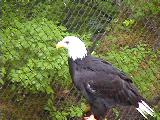
The winding Olga and Neva Straights are named after Russian ships.
I'm glad we choose to go with Cruise West and a small ship. Small ships offer a much more informal way to see Alaska, up close and personal. Able to transit the narrower channels of the most inner passages of the Inside Passage, they often poke their bows right into waterfalls or up to abandoned settlements. On a small ship, a whale sighting might interrupt dinner, and the bridge is open to all. This is the way to really see Alaska. I heard people say: No other vessel sailing in Alaska compares to the Spirit of Oceanus. No other vessel offers this level of luxury and personal attention as a 'standard' for all of her passengers, 5-Star elegant dining and relaxation in a 100% 'casual dress-down environment' day-in and day-out, and no other vessel can offer all of this with a unique and culturally diverse itinerary. That's pretty good, and I agree. I just can't imagine "seeing" Alaska from an inside cabin cruising the outside passage. On a small ship you can cruise the inside passage in an outside suite.
27 AUG 01
- Monday
We’re up early to enjoy this narrow passage into Juneau this morning. We
navigate Stevens Passage and the Gastineau Channel on our way into Juneau.
Considered by many to be the most beautiful capital city in the United States,
Juneau has something for everyone: scenery, wildlife, shopping, outdoor
activities, gold rush history, and warm, friendly residents.  Historic
downtown Juneau has a dramatic backdrop of towering mountains and looks out
over Gastineau Channel and the picturesque, historic community of Douglas
(once Alaska's largest town). Mendenhall Valley features Mendenhall Glacier
and Recreation Area, Mendenhall River and Juneau International Airport.
Historic
downtown Juneau has a dramatic backdrop of towering mountains and looks out
over Gastineau Channel and the picturesque, historic community of Douglas
(once Alaska's largest town). Mendenhall Valley features Mendenhall Glacier
and Recreation Area, Mendenhall River and Juneau International Airport.  Year round activities abound, from sight seeing to scuba diving, hiking to
guided tours.
Year round activities abound, from sight seeing to scuba diving, hiking to
guided tours.
The Alaska State Museum and Juneau-Douglas City Museum both offer a detailed
look at Juneau and Alaska. Gold put this city on the map and "The Glory
Hole" was the nickname for the cavernous entrance to the Treadwell Mine,
across the channel at Douglas. In those turn of the century days, men were
cheap and safety regulations few, and sometimes a miner a week went to glory
in mine accidents. Today Juneau is a more cosmopolitan place where the
government is the biggest employer. Surrounded by wilderness it is a town
where you can come out of an espresso shop and find a bear rummaging in a
trashcan. Cruise ships tie up right downtown, a short walk from South Franklin
St, Juneau's main visitor shopping area.
We chose the excursion on the scenic Glacier Highway to the Mendenhall Glacier
with its rugged crevasses and distinctive blue coloring. It is one-and-a-half
miles wide, hundreds of feet thick, and fed by a 1,500 square-mile ice field.
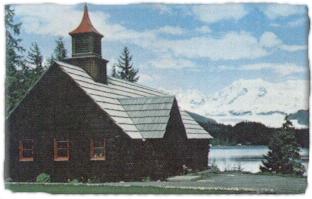 First we stopped at the Chapel by the Lake, a little log church with a truly
inspirational view of Auke Lake and the Mendenhall Glacier. The historic log
chapel was constructed in the mid-1950's. Sunday services are held in
this picturesque and popular tourist site. In addition to the log chapel, the
Chapel by the Lake campus includes a main sanctuary, fellowship hall,
education wing, and quarters for the pastor's family and the caretakers.
First we stopped at the Chapel by the Lake, a little log church with a truly
inspirational view of Auke Lake and the Mendenhall Glacier. The historic log
chapel was constructed in the mid-1950's. Sunday services are held in
this picturesque and popular tourist site. In addition to the log chapel, the
Chapel by the Lake campus includes a main sanctuary, fellowship hall,
education wing, and quarters for the pastor's family and the caretakers.
The meandering river of compressed ice that is the Mendenhall Glacier ranks
as the largest glacier accessible by road. The Glacier Visitors' Center,
offering a wealth of information on glaciers, is the perfect vantage point to
photograph this world-famous sight. John Muir described the Mendenhall glacier
as "one of the most beautiful of all the coastal glaciers." It is
formed from several tributary glaciers flowing from the 1,500-square-mile
Juneau ice field. As two glaciers carve their way around 3,000-foot rock
sentinels, smaller glaciers dramatically stream from the surrounding mountains
and ice field toward the valley below. The Juneau Ice Field straddles the
Coast Mountains between Mount Hefty in the north to Devil's Paw in the south.
Some of the more famous glaciers of this ice field include the advancing Taku
Glacier, the massive Llewellyn Glacier that drains into Atlin Lake, the
Hole-in-Wall Glacier (a tributary of the famous Taku Glacier), and the most
accessible glacier, Mendenhall Glacier, which is on the southwest side of the
Juneau Ice Field.
We decided to brave the elements and take the hike in the rain on the 3
miles trail  to
the big waterfall.
to
the big waterfall. 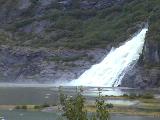 On
the way we encountered a black bear on the trail, but he saw us first and
quickly disappeared into the bushes. We returned to Juneau and had a late
lunch at the Red Dog Saloon. We then enjoyed walking around town until
dinner-time. 2 Holland America ships and 2 Royal Caribbean ships had just
dropped 9,000 people into town. That was a bit of a chock to me to see so many
people at one time. We sure appreciated even more the benefits of a small ship
and out of the way small fishing villages, where big ships don't go.
On
the way we encountered a black bear on the trail, but he saw us first and
quickly disappeared into the bushes. We returned to Juneau and had a late
lunch at the Red Dog Saloon. We then enjoyed walking around town until
dinner-time. 2 Holland America ships and 2 Royal Caribbean ships had just
dropped 9,000 people into town. That was a bit of a chock to me to see so many
people at one time. We sure appreciated even more the benefits of a small ship
and out of the way small fishing villages, where big ships don't go.
Cruise West includes one night before or after your cruise at the Goldbelt Hotel on 51 Egan Drive. This way you have a chance to enjoy the port city also.
28
AUG 01 -
Tuesday
Our flight leaves in the afternoon, so we have the morning free to enjoy
Juneau some more. We made a quick visit to the great Alaska State Museum with
tickets given to us by Cruise West. The official repository of the state's
history, the Alaska State Museum is charged with collecting and interpreting a
wealth of ethnographic and historical material. From an Aleut thimble basket
to the life-sized eagle tree, the Alaska State Museum offers visitors a chance
to "see" all the state within four walls. This is a must see very
interesting museum.
We also rode the brand new Mt. Roberts Tramway to the top of Mt. Roberts. 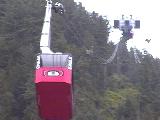
It’s located right on the cruise ship dock and offers a dramatic trip to the
mountaintop with spectacular views. 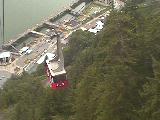 At the top are the Chilkat Theatre, an interpreted trail,
At the top are the Chilkat Theatre, an interpreted trail,  and restaurant and gift shop. We had a perfect view of the Norwegian Sky and
Sea Princess arriving with thousands of people for the day.
and restaurant and gift shop. We had a perfect view of the Norwegian Sky and
Sea Princess arriving with thousands of people for the day.
Cruise West had arranged for our
transfer to the airport for our Alaska flight 63 nonstop back to Seattle. It's
a 2 hours and 15 minutes flight. We spotted many glaciers on the way, and
when we saw Mt. Rainier, we knew we were home. Our mountain is very special to
us. 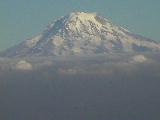 This
is a gorgeous mountain.
This
is a gorgeous mountain.
PS. I just toured this ship again on a quick overnight from Seattle to Vancouver on May 21, 2002. Cruise West is keeping this ship in very good condition. She needed some work after having been transferred from a Renaissance ship to a casino gambling ship in Singapore, where Cruise West picked her up a year ago. The beautiful wrap-around teak deck was badly warped and dangerous to run on. I was happy to see that this has been repaired and the sanding and oiling is underway and will be finished before she starts her summer season and picks up passengers in Anchorage for her cruise to the Behring Sea with Buzz Aldrin. Many crew members have signed on again and remembered me. I think that speaks highly of Cruise West's ability to hire and retain good people. Now the ship runs smoothly.
Remember your choice is simple: an inside cabin in the outside passage or an outside cabin in the inside passage.
